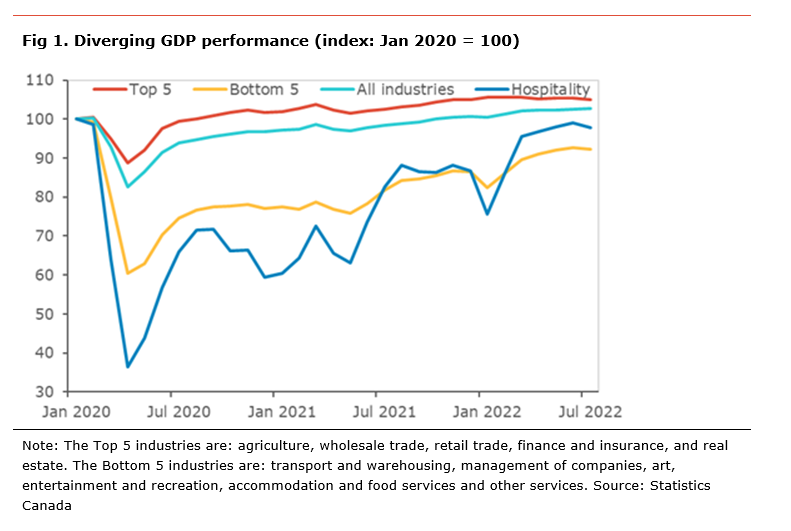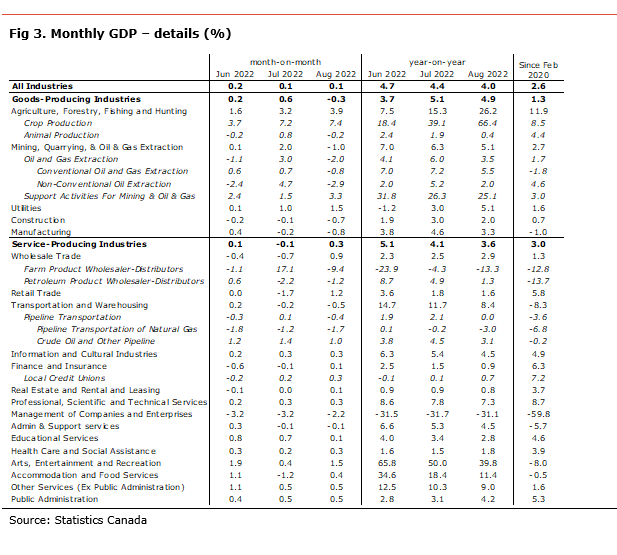Economic insight provided by Alberta Central Chief Economist Charles St-Arnaud.
Bottom line
Today’s release of the GDP for August confirms that growth has slowed rapidly in the second half of 2022, with growth at its weakest since 2021Q2 when restrictions to slow the spread of COVID were in effect. The report shows that rate-sensitive sectors are feeling the impact of rising interest rates.
We expect growth in Canada to remain anemic in the second half of 2022 as the impact of fast-rising interest rates starts to impact the broad economy. As such, the “Great consumer squeeze,” an erosion of purchasing power and rising debt-service cost, will slow household spending meaningfully and could be the source of an economic contraction early next year. Furthermore, despite a slowing economy, the Bank of Canada (BoC) continues to signal that more interest rate increases will be required to bring inflation down. As such, we believe that the BoC will hike its policy rate by 0.25bp at its December meeting.
For Alberta, the details available in the report suggest that economic activity was mixed in August due to a decline in oil and gas extraction, likely partly offset by higher support activity in the oil&gas sector and a surge in activity in the agricultural sector due to a bumper crop. High energy prices are a tailwind to the Alberta economy this year, but not as much as in the past (see Where’s the boom? How the impact of oil on Alberta may have permanently weakened). This will mean that Alberta’s slowdown in economic activity in the second half of the year could be less pronounced than in the rest of Canada.
The monthly GDP inched higher by 0.1% m-o-m in August (+4.0% y-o-y). The details show that 14 out of 20 industrial sectors posted gains on the month. Despite the overall economy being 2.6 percentage points above its pre-pandemic level, 6 out of 20 industrial sectors still have economic activity below their pre-pandemic levels, namely manufacturing, transportation and warehousing, management of companies, administration and support services, arts, entertainment and recreation, and accommodation and food services.
Statistics Canada’s preliminary estimate for September points to a 0.1% m-o-m gain. This suggests that growth in the third quarter of 2022 will likely be around 0.4% q-o-q ar. This would be the weakest quarterly growth since 2021Q1 when restrictions were put in place to slow the spread of COVID.
The goods-producing side of the economy expanded by 0.3% m-o-m in August. This was mainly due to a drop in activity in natural resources extraction (-1.0% m-o-m), manufacturing (-0.8% m-o-m) and construction (-0.7% m-o-m). Those declines were partly offset by increases in agriculture (+3.9% m-o-m) and utilities (+1.5% m-o-m).
The services-producing side of the economy rose 0.3% in August. The increase in activity was led by retail trade (+1.2% m-o-m), wholesale trade (+0.9% m-o-m), arts, entertainment and recreation (+1.5% m-o-m), public administration (+0.5% m-o-m), and other services (+0.5% m-o-m). A decline in transportation and warehousing (-0.5% m-o-m) offset some of the rises in other sectors.
For Alberta, there is no specific data in the report. However, we can make an assessment based on activity in some key industries specific to Alberta. The level of activity in the oil and gas sector, especially oil sands, decreased sharply on the month. However, this decline may have been partly offset by a rise in support activities for mining, oil and gas. There was also a decline in pipeline activity due to lower activity in gas pipelines. Strong growth in crop production positively affected the province. Overall, this means that the province’s economy likely grew at roughly the same pace as the rest of the country in August.



Independent Opinion
The views and opinions expressed in this publication are solely and independently those of the author and do not necessarily reflect the views and opinions of any organization or person in any way affiliated with the author including, without limitation, any current or past employers of the author. While reasonable effort was taken to ensure the information and analysis in this publication is accurate, it has been prepared solely for general informational purposes. There are no warranties or representations being provided with respect to the accuracy and completeness of the content in this publication. Nothing in this publication should be construed as providing professional advice on the matters discussed. The author does not assume any liability arising from any form of reliance on this publication.
Alberta Central member credit unions can download a copy of this report in the Members Area here.